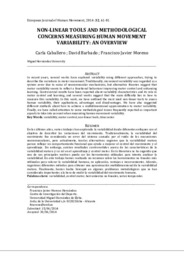Please use this identifier to cite or link to this item:
https://hdl.handle.net/11000/30892Full metadata record
| DC Field | Value | Language |
|---|---|---|
| dc.contributor.author | Caballero, Carla | - |
| dc.contributor.author | Barbado, David | - |
| dc.contributor.author | Moreno, Francisco Javier | - |
| dc.contributor.other | Departamentos de la UMH::Ciencias del Deporte | es_ES |
| dc.date.accessioned | 2024-01-31T13:21:16Z | - |
| dc.date.available | 2024-01-31T13:21:16Z | - |
| dc.date.created | 2014 | - |
| dc.identifier.citation | European Journal of Human Movement, 2014: 32, 61-81 | es_ES |
| dc.identifier.issn | 2386-4095 | - |
| dc.identifier.uri | https://hdl.handle.net/11000/30892 | - |
| dc.description.abstract | In recent years, several works have explored variability using different approaches, trying to describe the variations in motor movement. Traditionally, movement variability was regarded as a system error due to noise of neuromuscular mechanisms, but alternative theories suggest that motor variability seems to reflect a functional behaviour improving motor control and enhancing learning. Controversial results have been reported about variability characteristics and its role in motor control and learning, and several works suggest that the main difficulty lies in how to measure this variability. In this work, we have outlined the most used non-linear tools to assess human variability, their applications, advantages and disadvantages. We have also suggested different methods about how to achieve a multidimensional approximation to motor variability. Finally, we have called attention to some methodological issues frequently reported as important aspects to take into account when measuring human movement variability. | es_ES |
| dc.description.abstract | En los últimos años, varios trabajos han explorado la variabilidad desde diferentes enfoques con el objetivo de describir las variaciones del movimiento. Tradicionalmente, la variabilidad del movimiento fue considerada un error del sistema causado por el ruido de los mecanismos neuromusculares, pero actualmente, teorías alternativas sugieren que la variabilidad motora parece reflejar un comportamiento funcional que ayuda a mejorar el control del movimiento y el aprendizaje. Sin embargo, existen resultados controvertidos acerca de las características de la variabilidad motora y su rol en el aprendizaje y control motor. En la literatura se ha sugerido que uno de sus principales motivos puede ser las herramientas utilizadas para intenta analizar la variabilidad. En este trabajo hemos realizado un resumen sobre las herramientas no lineales más utilizadas para valorar la variabilidad humana, su aplicación, ventajas e inconvenientes. Además, sugerimos diferentes métodos para obtener una aproximación multidimensional de la variabilidad motora. Finalmente, hemos hecho hincapié en algunos problemas metodológicos que se han considerado importantes a la hora de medir la variabilidad del movimiento humano. | es_ES |
| dc.format | application/pdf | es_ES |
| dc.format.extent | 21 | es_ES |
| dc.language.iso | eng | es_ES |
| dc.publisher | Asociación Española de Ciencias del Deporte | es_ES |
| dc.rights | info:eu-repo/semantics/openAccess | es_ES |
| dc.rights | Attribution-NonCommercial-NoDerivatives 4.0 Internacional | * |
| dc.rights.uri | http://creativecommons.org/licenses/by-nc-nd/4.0/ | * |
| dc.subject | variability | es_ES |
| dc.subject | motor control | es_ES |
| dc.subject | non-linear tools | es_ES |
| dc.subject | time series | es_ES |
| dc.subject | variabilidad | es_ES |
| dc.subject | control motor | es_ES |
| dc.subject | herramientas no lineales | es_ES |
| dc.subject | series temporales | es_ES |
| dc.subject.classification | Educación física y deportiva | es_ES |
| dc.subject.other | CDU::7 - Bellas artes::79 - Diversiones. Espectáculos. Cine. Teatro. Danza. Juegos.Deportes | es_ES |
| dc.title | Non-linear tools and methodological concerns measuring human movement variability | es_ES |
| dc.type | info:eu-repo/semantics/article | es_ES |

View/Open:
2014_EJHM.pdf
235,06 kB
Adobe PDF
Share:
.png)
